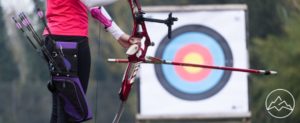Are you embarking on an archery journey and in search of the perfect bow? With the multitude of options available, selecting the right bow can be a daunting task. However, by understanding the different types and styles of bows, as well as considering factors such as handedness, eye dominance, draw length, and draw weight, you can make an informed decision. In this article, we will explore the various types of bows, including longbow, recurve, compound, and traditional bows, and highlight their unique features and benefits. We will also discuss how to determine your handedness and eye dominance, as well as measure your draw length and weight. By following these guidelines, you will be well-equipped to choose a bow that suits your archery style and preferences. Whether you decide to seek professional guidance at a local archery shop or explore online options, the process of finding the perfect bow should be an enjoyable one. So, let’s dive in and discover the ideal bow for your archery journey.
Key Takeaways
- Understand the different types and styles of bows before making a purchase.
- Consider personal preferences and archery style when choosing the right bow type.
- Take into account factors such as handedness, eye dominance, draw length, and draw weight when selecting a bow.
- Explore various buying options, including local archery shops, online stores, and used equipment from the archery community.
Types of Bows
The pre-existing knowledge provides an overview of the different types of bows, including longbows, recurve bows, compound bows, and traditional bows, which are important to consider when choosing the perfect bow for your archery journey. Choosing the right bow type for your archery style is crucial in ensuring a satisfying experience. Longbows are favored by archers interested in traditional style archery due to their simple design. Recurve bows, with their arced limbs that curve forward, offer faster speeds and smoother draws. Compound bows, on the other hand, utilize leverage and have pulleys and cams for increased speed and easier holding at full draw. Traditional archery, performed with recurve bows and longbows, is simple and straightforward, while modern archery incorporates technology and can include compound bows or modern recurve bows. Exploring the pros and cons of buying a bow online is also important, as it offers convenience but requires careful consideration of measurements and criteria beforehand.
Determining Handedness and Eye Dominance
Determining handedness and eye dominance can provide valuable information when selecting the most suitable bow for an individual’s archery pursuits, even though some may argue that these factors have minimal impact on the overall archery experience. However, considering handedness and eye dominance can greatly affect an archer’s accuracy and comfort. Here are four key points to consider:
- Choosing the right bow style: Determining handedness is crucial in selecting a bow that matches the dominant hand. Right-handed individuals should use a right-handed bow, and vice versa for left-handed individuals. This ensures proper grip and control.
- The importance of personal attention: Archers should seek personal attention from experienced professionals to determine their eye dominance. This information is vital in choosing the appropriate bow and accessories, such as sights, to enhance accuracy.
- Eye dominance and aiming: Knowing which eye is dominant helps archers align their aim more effectively. It ensures that the bow is properly aligned with the dominant eye, resulting in improved accuracy and consistency.
- Comfort and consistency: When a bow is matched correctly to an archer’s handedness and eye dominance, it promotes a more comfortable shooting experience. This, in turn, leads to better consistency in form and shot execution.
By considering handedness and eye dominance, archers can select the right bow style and accessories, ensuring a more personalized and optimal archery experience.
Measuring Draw Length and Weight
Measuring draw length and weight is an essential step in the process of selecting a suitable bow for an individual’s archery needs. Choosing the right bow for your archery journey requires careful consideration of various factors, and selecting the appropriate draw weight and length is of utmost importance. Draw length is the distance between the bowstring at full draw and the bow grip, and it determines the amount of power an archer can generate. It can be measured by determining the arm span and dividing it by 2.5. Draw weight, on the other hand, refers to the force required to draw back the bow. It should be chosen based on the type of bow, age, and gender of the archer. It is recommended to start with a lighter draw weight and gradually increase as strength improves. By accurately measuring draw length and weight, archers can ensure they find a bow that suits their individual needs and abilities.
Frequently Asked Questions
What are the advantages and disadvantages of buying a used bow?
When considering the advantages and disadvantages of buying a used bow, several factors need to be considered. Pros of buying a used bow include cost savings and the potential to find a higher quality bow within a limited budget. Additionally, used bows may already have accessories included. However, there are also cons to be aware of, such as potential wear and tear, limited warranty or support, and the need for thorough inspection to ensure the bow is in good condition.
Are there any specific safety precautions to keep in mind when using a compound bow?
One statistic that highlights the importance of safety precautions when using a compound bow is that approximately 7,000 archery-related injuries occur each year in the United States alone. To ensure safety, it is crucial to follow proper technique when using a compound bow. This includes wearing proper protective gear such as arm guards, finger tabs, and a release aid. It is also important to maintain a proper stance, grip, and alignment while shooting to prevent accidents and injuries.
Can I use a compound bow for traditional archery?
Yes, a compound bow can be used for traditional archery. While traditional archery is often associated with recurve bows and longbows, modern compound bows can also be used in this style of archery. However, it is important to note that the design and technology of compound bows may not align with the simplicity and traditional aesthetics typically associated with traditional archery. Nonetheless, the choice of using a compound bow for traditional archery is a matter of personal preference and individual archer’s goals and preferences.
How often should I check and maintain my bow?
How often should one check and maintain their bow? Regular maintenance is crucial to ensure optimal performance and safety. It is recommended to inspect your bow before each use and perform routine maintenance every few months. This includes checking for any signs of damage, adjusting the bowstring, and lubricating moving parts. As for purchasing a used bow, it can be a cost-effective option but comes with potential risks. One must carefully evaluate the condition, history, and compatibility of the used bow before making a decision.
Are there any legal requirements or restrictions for owning a bow?
Legal requirements and age restrictions for owning a bow vary depending on the jurisdiction. In many countries, there are no specific legal requirements for owning a bow, and they are generally considered legal for individuals of all ages to possess. However, it is important to research and comply with local laws and regulations, as some regions may have age restrictions or licensing requirements for the purchase or use of bows. It is advisable to consult with local authorities or a legal professional to ensure compliance with applicable laws.
Conclusion
In conclusion, choosing the perfect bow for your archery journey requires careful consideration of various factors such as the type of bow, handedness, eye dominance, draw length, and draw weight. Understanding these elements will help you select a bow that suits your personal preferences and archery style. Whether you opt for a longbow, recurve, compound, or traditional bow, the key is to find one that fits well and meets your needs. Exploring different options, both online and locally, will ensure a successful and enjoyable archery experience. So, embark on your archery journey with anticipation and excitement, knowing that the perfect bow awaits.










